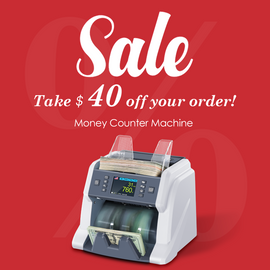Coin sorting machines have become increasingly popular in recent years due to their convenience and cost-effectiveness. These machines are typically used by businesses, banks, and other organizations that handle large volumes of coins on a daily basis. Therefore, they have to be incredibly precise in identifying different types of coins, and they do so using a combination of several technologies.This article will discuss the various methods coin sorter machines use to identify different coins.
-
Weight and diameter measurement: Coins of different denominations often have different weights and diameters, and these can be used to differentiate between them. The machine measures the weight and diameter of each coin and compares it to the standard specifications for each denomination.
-
Magnetic properties: Coins are made of different materials, some of which are magnetic. The coin sorting machine uses a magnetic sensor to detect the magnetic properties of each coin and identify it based on that.
-
Optical recognition: Coins can have different designs and textures, which can be captured by an optical sensor and used to identify them. The machine takes a digital image of each coin and compares it to its database of known coin designs to identify it.
-
Infrared spectroscopy: Coins of different denominations may have different infrared spectra, which can be used to identify them. The machine uses an infrared sensor to scan the coin and analyze its spectrum, and then identifies it based on that.
-
Eddy current detection: This involves passing a coin through a magnetic field, which creates eddy currents in the metal. The size and frequency of these currents can be used to identify the type of metal in the coin and thus, identify the coin.
-
Ultrasonic testing: Coins of different thicknesses will produce different echoes when subjected to ultrasonic waves, which can be used to identify them. The machine uses ultrasonic sensors to measure the echoes produced by each coin and identify it based on that.
- Radio Frequency Identification (RFID) : some coin sorting machines also utilize RFID technology to identify coins. This is one of the most reliable methods of coin identification. It involves placing an RFID chip onto each coin before it is sorted. When the coin passes through the sorting machine, the RFID chip is read and the coin is classified according to its value. This technology is especially useful for sorting large numbers of coins quickly and accurately.
Generally, coin sorting machines use a combination of these technologies to accurately identify different types of coins. For example, the mechanical coin sorter machine, which relys on a combination of sensors, magnets, and weight scales to identify coins. As coins are inserted into the machine, a sensor scans each one to detect its size and shape. Magnets are then used to verify the metal composition of the coin, which helps the machine determine its denomination and value. Finally, the coin is weighed using a specialized scale to confirm its authenticity. Once all of this information has been gathered, the coin machine can accurately classify the coin and store it accordingly.
In conclusion, there are several different methods that coin sorting machines use to identify different coins. All of these techniques allow machines to quickly and accurately sort coins by denomination and value, making them a convenient and cost-effective solution for businesses, banks, and other organizations that handle large volumes of coins on a regular basis. With the right coin sorting machine, you can make counting your coins much easier and more efficient.
Frequently Asked Quesitons
Is there a coin-sorting/counting machine that can also identify valuable coins?
While the idea of a coin-sorting machine that can also identify valuable coins is intriguing, as of now, such a machine does not exist. The primary reason is the complexity involved in identifying valuable coins. Unlike regular coins, whose value is determined by their denomination, valuable coins may have additional factors such as rarity, historical significance, or unique minting errors that contribute to their worth. These factors often require expert evaluation and cannot be easily quantified or programmed into a machine. Moreover, the technology needed to assess these factors would have to be incredibly advanced, incorporating not just weight, diameter, and material analysis, but also detailed visual inspections and possibly even historical data analysis. This would make the machine exceedingly complex and expensive to produce. Therefore, while current coin-sorting machines are highly efficient in sorting coins by denomination using a combination of technologies like weight measurement, magnetic properties, and optical recognition, they are not equipped to identify coins that are valuable for reasons beyond their face value.








1 comment
NICE ARTICLE BUT YOU CONVENIENTELY DODGED THE ORIGINAL QUESTION, “Is there a machine that can detect rare coins?” NOT DIFFICULT!!!!